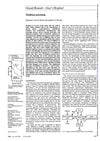Thallium Poisoning: Emphasis on Early Diagnosis and Response to Hemodialysis
February 2003
in “
Postgraduate Medical Journal
”
TLDR Early diagnosis and haemodialysis can effectively treat thallium poisoning.
A 42-year-old man with thallium poisoning initially presented with symptoms mimicking Guillain-Barré syndrome and arsenic poisoning, including flaccid quadriparesis, paresthesia, loose motions, skin lesions, and organ dysfunction. By the second week, he developed additional symptoms such as ophthalmoplegia, nystagmus, neck tremor, and later alopecia, leading to the suspicion of thallium poisoning. His serum thallium level was 40,980 μg/ml on the 18th day. Treatment included haemodialysis, potassium supplementation, laxatives, and B complex vitamins, resulting in significant improvement. At three months, he could walk with support, and at six months, he was independent in daily activities. The study highlighted that severe paresthesia, ophthalmoplegia, cerebellar and extrapyramidal signs, and alopecia are indicative of thallium poisoning, and haemodialysis can be effective even in the third week of poisoning.


